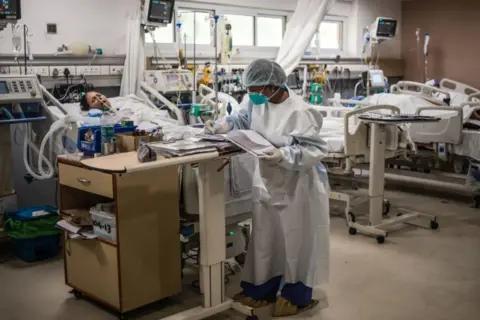ARTICLE AD BOX

 Corbis via Getty Images
Corbis via Getty Images
India is among the countries hardest hit by "antimicrobial resistance"
It's a grim paradox, doctors say.
On the one hand, antibiotics are being overused until they no longer work, driving resistance and fuelling the rise of deadly superbugs. On the other hand, people are dying because they can't access these life-saving drugs.
A new study by the non-profit Global Antibiotic Research and Development Partnership (GARDP) looked at access to antibiotics for nearly 1.5 million cases of carbapenem-resistant Gram-negative (CRGN) infections across eight major low- and middle-income countries, including India, Brazil and South Africa. CRGN bacteria are superbugs resistant to last-line antibiotics - yet only 6.9% of patients received appropriate treatment in the countries studied.
India bore the lion's share of CRGN infections and treatment efforts, procuring 80% of the full courses of studied antibiotics but managing to treat only 7.8% of its estimated cases, the study in The Lancet Infectious Diseases journal reports. (A full drug course of antibiotics refers to the complete set of doses that a patient needs to take over a specific period to fully treat an infection.)
Common in water, food, the environment and the human gut, Gram-negative bacteria cause infections such as urinary tract infections (UTIs), pneumonia and food poisoning.
They can pose a serious threat to newborns and the elderly alike. Especially vulnerable are hospital patients with weakened immunity, often spreading rapidly in ICUs and proving difficult - and sometimes impossible - to treat. Treating carbapenem-resistant Gram-negative bacterial infections is doubly difficult because those bacteria are resistant to some of the most powerful antibiotics.
"These infections are a daily reality across all age groups," says Dr Abdul Gaffar, infectious disease consultant at Apollo Hospital in India's Chennai city. "We often see patients for whom no antibiotic works - and they die."
The irony is cruel. While the world tries to curb antibiotic overuse, a parallel tragedy plays out quietly in poorer nations: people dying from treatable infections because the right drugs are out of reach.

 Getty Images
Getty Images
Gram negative bacteria spread rapidly in places like hospital ICUs
"For years, the dominant narrative has been that antibiotics are being overused, but the stark reality is that many people with highly drug-resistant infections in low- and middle-income countries are not getting access to the antibiotics they need," says Dr Jennifer Cohn, GARDP's Global Access Director and senior author of the study.
- India's 'blockbuster' drugs to take on deadly superbugs
- India facing a pandemic of antibiotics-resistant superbugs
The study examined eight intravenous drugs active against carbapenem-resistant bacteria - ranging from older antibiotics including Colistin to newer ones such as Ceftazidime-avibactam. Of the few available drugs, Tigecycline was the most widely used.
Researchers blame the treatment gap on weak health systems and limited access to effective antibiotics.
For example, only 103,647 full treatment courses were procured of Tigecycline across eight countries - far short of the 1.5 million patients who needed them, the study found. This highlighted a major shortfall in the global response to drug-resistant infections.
What prevents patients with drug-resistant infections in India from getting the right antibiotics?
Physicians point to multiple barriers - reaching the right health facility, getting accurate diagnostic tests, and accessing effective drugs. Cost remains a major hurdle, with many of these antibiotics priced far beyond the reach of poorer patients.

 Universal Images Group via Getty Images
Universal Images Group via Getty Images
A electron micrograph of carbapenem-resistant bacteria
"Those who can afford these antibiotics often overuse them; those who can't, don't get them at all," says Dr Gaffar. "We need a system that ensures access for the poor and prevents misuse by the well-to-do."
To improve access, these drugs must be made more affordable. To prevent misuse, stronger regulation is key.
"Ideally, every antibiotic prescription in hospitals should require a second sign-off - by an infection specialist or microbiologist," says Dr Gaffar. "Some hospitals do this, but most don't. With the right oversight, regulators can ensure this becomes standard practice."
To fix the access problem and curb misuse, both smarter policies and stronger safeguards are essential, say researchers. But access alone won't solve the crisis - the pipeline of new antibiotics is drying up. The decline in antibiotic R&D - and the limited availability of existing drugs - is a global issue.
India bears one of the world's heaviest burdens of antimicrobial resistance (AMR), but it may also hold the key to combating it - both at home and globally, researchers say.
"India is also one of the largest markets for new antibiotics and can successfully advocate for the development and access of new antibiotics," says Dr Cohn. With a strong pharmaceutical base, the country is emerging as a hub for AMR innovation, from promising new antibiotics to advanced diagnostics.
Dr Cohn says India can strengthen its antibiotic response by generating local data to better estimate needs and pinpoint gaps in the care pathway.
This would allow for more targeted interventions to improve access to the right drugs.
Innovative models are already emerging - Kerala state, for instance, is using a "hub-and-spoke approach" to support lower-level facilities in managing serious infections. Coordinated or pooled procurement across hospitals or states could also reduce the cost of newer antibiotics, as seen with cancer drug programs, researchers say.
Without access to the right antibiotics, modern medicine begins to unravel - doctors risk losing the ability to safely perform surgery, treat complications in cancer patients, or manage everyday infections.
"As an infectious disease doctor, I see appropriate use as one part - but only one part - of access," says Dr Gaffar. "When we get new antibiotics, it's important to save them on one hand - and save them for right patients."
Clearly, the challenge is not just to use antibiotics wisely, but to ensure they reach those who need them most.

 1 day ago
5
1 day ago
5








 English (US) ·
English (US) ·